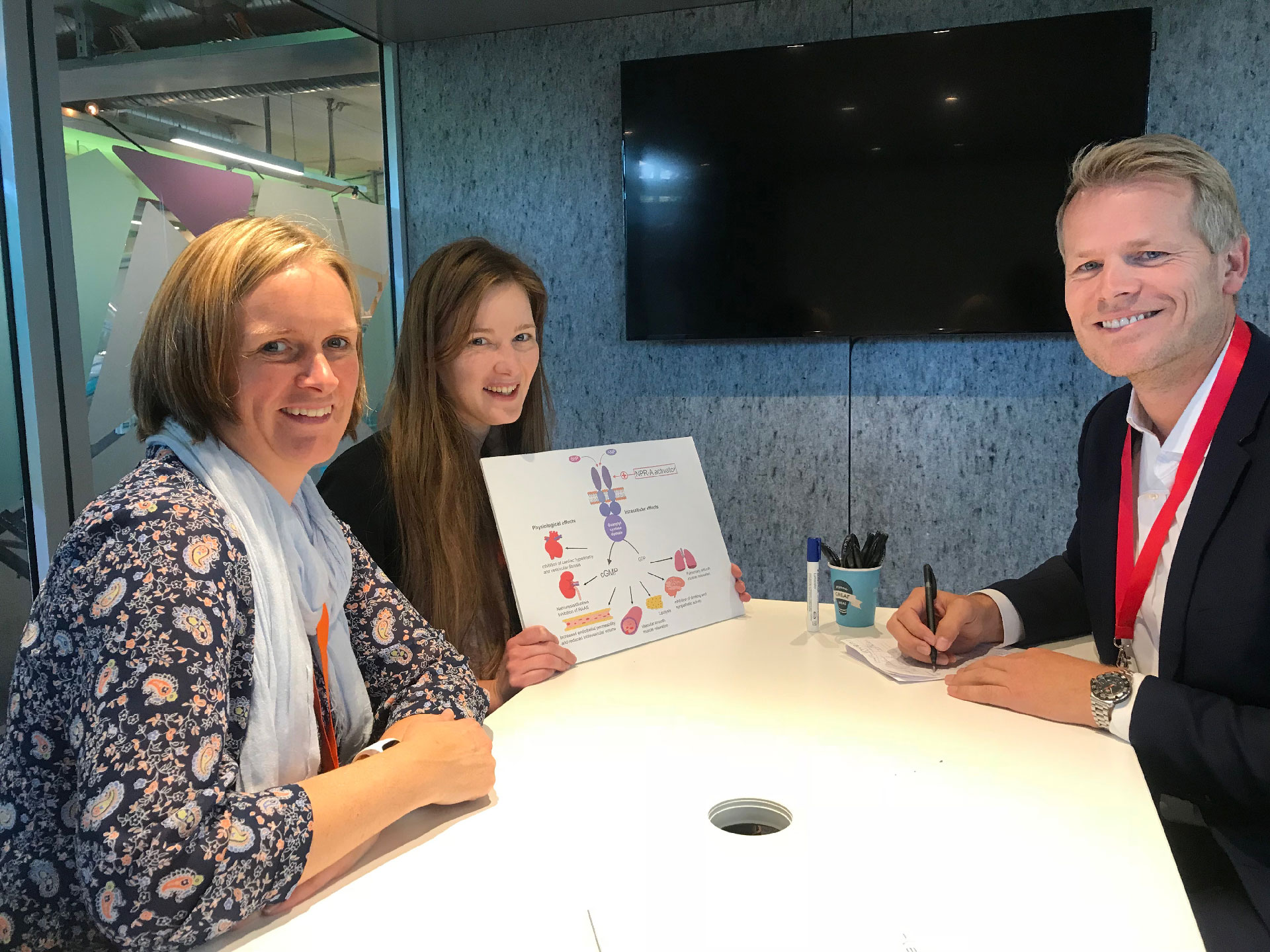USEFUL AND IMPORTANT MATCHMAKING AT CUTTING EDGE
Almost 90 1:1 meetings between researchers, mature companies and start-ups were held at this year’s Cutting Edge. “We received important feedback,” says researcher Henriette Andresen after her meeting with Pfizer.

FOTO: Elisabeth Kirkeng Andersen
At the health incubator Aleap, people met across industry, academia, the hospital sector and businesses in the start-up phase for meetings that ran alongside all the other events at the annual Cutting Edge Festival. This partnering offer at Norway’s biggest technology and research festival goes under the name ‘matchmaking’.
“This year’s matchmaking was very successful. There were 88 meetings in all, and we received good feedback from the participants,” says Lise Rødsten.
Rødsten is responsible for industry cooperation at Inven2 and has organised many meetings for researchers from the University of Oslo and Oslo University Hospital.
Met Pfizer
Henriette Andresen is a research fellow at the Department of Clinical Medicine at UiO. She took part in the matchmaking along with her colleague Lise Roman Moltzau.
They recently received several millions in funding from the Research Council of Norway for an innovation project to develop a new treatment for high blood pressure where the medicines currently available are not effective, known as resistant hypertension. Read more at the bottom of the article.
One of the people that Andresen and Moltzau met at the matchmaking was Pål Falck, who is medical advisor and scout for new cooperation projects at Pfizer.
“Pål gave us very valuable feedback. It was particularly useful to learn that Pfizer can also assist us with our research,” says Andresen.
Falck, on his part, had already been informed by Inven2 about Andresen and Moltzau’s project.
“Inven2 are good at keeping us in the pharmaceutical industry up to speed on their early-stage projects. It is nonetheless important to learn more about the project by meeting the researchers directly early on.”
Falck also gave the researchers advice on what they should consider in the innovation project in order to make it attractive and relevant to the industry.
“We’re researchers and research is obviously what we are best at, so all information about commercial development is useful to us. It is essential to hear directly from the industry what standards are required and what is possible in terms of cooperation,” says Moltzau.
Difficult to make the cut, but dialogue most important
Pfizer only enters into collaborations with researchers on about 150 innovation projects each year on a global basis. This does not scare off Moltzau and Andresen.
“Our project is still at an early stage, and just now, dialogue with the industry is what is most valuable so as to hear what they are looking for,” says Andresen.
Falck is clear that it is very difficult to make the cut. His job now is to find the right colleague among Pfizer’s 90,000 employees worldwide to evaluate the Norwegian researchers’ project.
“I’m working hard to market Norwegian projects. It’s important to us who work at Pfizer in Norway to make this work,” says Falck.
He finds it particularly interesting that the project is in the early phase and aimed at a niche.
Collaboration increasingly important
The biopharmaceutical industry is increasingly working through collaborations with academia, start-ups and other major global corporations. One example is a new collaboration between Imtech at Oslo University Hospital and GE Healthcare in the field of radiology that was presented at Cutting Edge.
Pfizer’s strategy includes shared laboratories.
“Pfizer global has recently established some brand-new research labs in the USA, where researchers from academia and researchers at Pfizer work side by side and together, often in cooperation with representatives of patient organisations,” says Falck.
Pfizer’s business model indicates that around half of all new products launched stem from cooperation agreements with academia or private companies.
“The cooperation model used in the biopharmaceutical industry applies to technology-intensive business activities in general. This means that taking part in 1:1 meetings is more important than ever for all researchers,” says Rødsten.
The Cutting Edge festival attracts researchers, technologists and companies from all over Norway in Oslo Science Park, and is therefore particularly suitable for matchmaking across disciplines.
“For researchers and technologists in Oslo Science Park and the surrounding institutions, this is an attractive low-threshold event practically on their doorstep,” says Rødsten.
The researchers and Falck agree.
Promising innovation project
Between 10 and 30 per cent of patients who suffer from high blood pressure see no improvement from antihypertensive drugs. The medicines basically have no effect on them.
Andresen and Moltzau and colleagues have received NOK 8 million in funding from the Research Council of Norway and NOK 800,000 from the university to develop new drugs for this patient group.
The project has also been included in UiO’s innovation programme SPARK NORWAY.
Andresen pitched the project at Cutting Edge as part of Launch Stage, a conference event aimed at innovative projects.
Read more about the project here.
Facts about this year’s Cutting Edge:
- Sixth in line
- 1,000 participants
- 5 keynote lectures
- 41 lectures
- 5 debates
- 2 workshops
- 50 stands
- 88 meetings during the matchmaking event
Cutting Edge is organised in cooperation with Inven2, OsloTech, the University of Oslo and Conventor.
Read more about how the partners work with Cutting Edge here.
Read more about this year’s Cutting Edge here.



 Norsk
Norsk